Beethoven: String Quartet No. 16 & Walton: Serenade for Strings
Amsterdam Sinfonietta, Candida Thompson
Arrangements for string orchestra of works originally written for string quartet are not uncommon, especially in the cases of Beethoven and Schubert… But in the amazing scherzo, with its huge... — More…
-
Gramophone MagazineMarch 2006Disc of the Month
Downloads
What are FLAC and MP3?Contents
Beethoven: String Quartet No. 16 in F Major, Op. 135 (Arr. for String Ensemble by Marijn van Prooijen)
Work length27:47
$5.00
$7.00
$8.70
$10.20
- Amsterdam Sinfonietta
- Candida Thompson
I. Allegretto
Track length6:51
$1.00
$1.40
$1.75
$2.05
II. Vivace
Track length3:31
$1.00
$1.40
$1.75
$2.05
III. Lento assai cantante e tranquillo - Più lento
Track length9:22
$1.50
$2.10
$2.60
$3.05
IV. Der schwer gefasste Entschluss. Grave, ma non troppo tratto - Adagio - Allegro
Track length8:03
$1.50
$2.10
$2.60
$3.05
Walton: Sonata for String Orchestra
Work length26:35
$5.00
$7.00
$8.70
$10.20
- Amsterdam Sinfonietta
- Candida Thompson
I. Allegro
Track length8:40
$1.50
$2.10
$2.60
$3.05
II. Presto
Track length4:13
$1.00
$1.40
$1.75
$2.05
III. Lento
Track length9:04
$1.50
$2.10
$2.60
$3.05
IV. Allegro molto
Track length4:38
$1.00
$1.40
$1.75
$2.05






